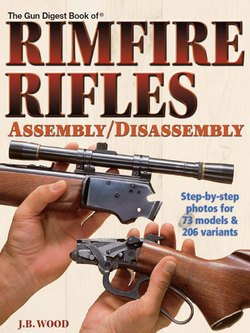Читать книгу The Gun Digest Book of Rimfire Rifles Assembly/Disassembly - J.B. Wood - Страница 9
На сайте Литреса книга снята с продажи.
Оглавление1. The tiniest of these fine German instrument screwdrivers from Brownells is too small for most gun work, but you’ll see the rest of them used frequently throughout the book. There are many tight places where these will come in handy.
2. When a larger screwdriver is needed, this set from Brownells covers a wide range of blade sizes and also has Phillips- and Allen-type inserts. The tips are held in place by a strong magnet, yet are easily changed. These tips are very hard. With enough force you might manage to break one, but they’ll never bend.
3. You should have at least one good pair of bent sharp-nosed pliers. These, from Brownells, have a box joint and smooth inner faces to help prevent marring.
4. For heavier gripping, these Bernard parallel-jaw pliers from Brownells have smooth-faced jaw-pieces of unhardened steel to prevent marring of parts.
5. For situations where a non-marring rap is needed, this hammer from Brownells is ideal. It is shown with nylon faces on the head, but other faces of plastic and brass are also available. All are easily replaceable.
6. For drifting out pins, these small all-metal hammers from B-Square are the best I’ve seen. Two sizes (weights) are available and they’re well worth the modest cost.
7. For situations where reach and accessibility are beyond the capabilities of sharp-nosed pliers, a pair of large sharp-nosed forceps (tweezers) will be invaluable.
8. One of the most-used tools in my shop is this nylon tipped drift punch, shown with an optional brass tip in place on the handle. It has a steel pin inside the nylon tip for strength. From Brownells, and absolutely essential.
9. A good set of drift punches will prevent a lot of marred pins. These, from Brownells, are made by Mayhew. The tapered punches at the right are for starting pins, the others for pushing them through. Two sizes are available-4 inches or 6 inches.
10. These punches by Mayhew are designed specifically for roll pins and have a projection at the center of the tip to fit the hollow center of a roll pin, driving it out without deformation of the ends. From Brownells.
11. Some of the necessary tools are easily made in the shop. These non-marring drift punches were made from three sizes of welder’s brazing rod.
12. From Brownells, this wrench is specifically designed for use on the barrel nut on the Winchester 150/250 and 190/290 series.
13. The B-Square stock bolt tool automatically centers in the access hole at the rear of the stock, and its wide cross-piece easily “finds” the screw slot. The T-handle gives good leverage.
14. This is the end of the B-Square general stock bolt tool, showing the replaceable crosspiece which contacts the screw slot.
15. This excellent new hammer from B-Square is the same size and weight as the larger of the two hammers shown elsewhere in the tool section, and has an additional feature-knurled replaceable striking faces, in your choice of brass or steel.
16. When dovetail-mounted sights are not super-tight, this “Sight-Pusher” will move them out or into place gently, without the marring which can occur with the hammer-and-drift method. From Williams.
Inner Magazine Tube Disassembly:
With very few exceptions, the disassembly of the inner magazine tube is the same for most rifles having this type of magazine system. The knurled knob at the end of the tube is retained by a cross pin, with one or both ends of the cross pin protruding to lock the tube in the gun. Most of the pins are driven out toward the non-protruding (or smooth) side. The tube should be supported in a V-block or a slightly opened bench vise during this operation, to avoid deformation of the thin walls of the tube. When the pin is out, the knob can be removed from the end of the tube, and this will release the magazine spring and follower. In some cases, the spring will be slightly compressed, so take care that it doesn’t get away, and ease it out. In those cases where the cross pin protrudes on both sides, the pin will be slightly tapered. These should be driven out toward the larger end of the pin. Some box-type magazines can be disassembled, but most of them are of staked construction, and in normal disassembly should not be taken apart.
A Note On Coin-Slotted Screws
Many action takedown screws and main stock retaining screws have slots designed for use with a coin, the theory being that a shooter in the field might not have a large screwdriver at hand, but would be likely to have pocket change. The slots in these screws are wider than normal, and the floor of the slots will be curved, to match the curve of a coin edge. It is possible, and advisable, for the gunsmith or advanced amateur to alter a large shop screwdriver to exactly fit these screws. In general, though, the following advice applies: Do not use an ordinary, unaltered large screwdriver on coin-slotted screws.
